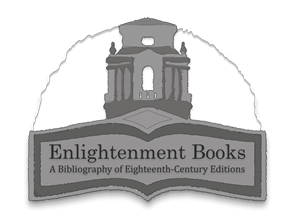The Enlightenment Books Project at Pomona College:
A Bibliographical Checklist of Eighteenth-Century Editions
Introduction and BackgroundThis database of 250+ book titles and 8000 records is the result of a team of undergraduate student researchers at Pomona College who have helped quantify the number of editions published between 1700-1800. Traditionally, professional bibliographers develop "checklists" of editions largely by travelling to libraries, comparing one edition against the other by physically examining them, and then describing them in a technical language accessible to specialists. For the Enlightenment, David Smith's bibliography for Helvétius and JoAnn McEachern's bibliographies for Rousseau are pillars of such scholarship. It would be impossible for a single scholar to extend what they have done to a larger group of 250 titles. Also, there is an important difference between a detailed bibliography and a bibliographic checklist. The latter is highly selective regarding the bibliographic information included.
With digitization and the ubiquity of WorldCat, however, it is now possible to innovate this process and thereby enhance its scale and usefulness. Yet one must admit that the bibliographic checklists that are drawn from WorldCat are sharply inferior to those by Smith and McEachern. And the ones displayed here are further marked by errors committed by a low-funded undergraduate researchers, for which I bear full responsibility. Therefore, the lists here should be taken as provisional, which is why we are releasing them to the public in a downloadable format, and encouraging scholars to improve them. Despite their flaws, these checklists are nonetheless valuable indicators of the popularity of certain Enlightenment books when compared with one another and with books outside the Enlightenment.
WorldCat is a decentralized database of library cataloguing records. When a librarian-cataloguer from a participating library creates an original record for a book, the record is uploaded into the database. During its early days, when WorldCat consisted largely of small-college libraries located in Ohio, it was not particularly comprehensive. But once the database expanded throughout North America and then spread to Europe and beyond (including the British Library and Bibliothèque Nationale de France), WorldCat became the most comprehensive bibliographic database in the world.
When a library joins WorldCat, all of its records are automatically uploaded to the database. Because all records are local and original, without any review process, WorldCat records are marked by countless duplications and many errors. After all, some records of these eighteenth-century books go back to the nineteenth century, when each library may have had its own unique cataloguing system. Likewise, there are endless variations of possible records, such as determining when an edition was published as part of a collected works project,
Such considerations mean that working with WorldCat is not easy, and certainly, not subject to blind automation. Each record needs to be evaluated on its own merits and carefully compared with other records. Often records have already been updated and linked with others. But often one finds unique records of a supposed edition that is located in only one library. These records need to be examined carefully with a skeptical eye.
The Pomona College students who worked on this database were trained in basic WorldCat usage. Through mainly trial and error, they developed methods for comparing one edition against another. Whenever possible, they used a digital copy of the book as a point of reference. Sometimes they would contact a librarian at a host institution for clarification. Whenever possible, already published checklists (often produced in scholarly editions) were consulted.
These 250+ titles are meant to represent the publishing history of the European Enlightenment. Because the Enlightenment was such a large movement in European intellectual life, the line between Enlightenment books and other eighteenth-century books more generally is blurry. At the same time, some books do not lend themselves to an edition checklist. These include multi-volume government-produced series (the most famous example here may be Buffon’s Histoire naturelle), musical scores, school textbooks, liturgical works, and the Bible. Quantifying editions is most appropriate when print runs were regulated by the vulnerability to government censorship and/or the lack of copyright protection. These issues are discussed at greater length in my forthcoming work, The Books That Made the European Enlightenment: A History in 12 Case Studies (London: Bloomsbury Academic, 2022), for which this database was developed.
